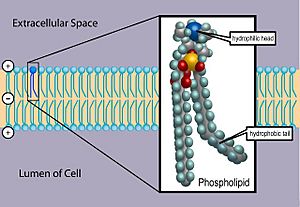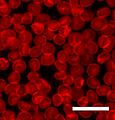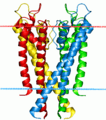Lipid bilayer facts for kids
Lipid bilayers are important in biological cells. They are the basis of cell membranes, and they surround most cell organelles. Lipid bilayers form automatically from phospholipids by self-assembly.
The phospholipids have heads which mix with water and tails which reject water. So the tails come together in the centre of the double layer, and the heads on the outside are surrounded by water.
The lipid bilayers stop most water-soluble (hydrophilic) molecules passing through. They also stop most ions.
In cells, proteins are put in the bilayer by enzymes. The proteins decide which molecules come in and which go out of the cell. For example, cells control salt concentrations and pH by pumping ions across their membranes using proteins called ion pumps.
Images for kids
-
This fluid lipid bilayer cross section is made up entirely of phosphatidylcholine.
-
Transmission Electron Microscope (TEM) image of a lipid vesicle. The two dark bands around the edge are the two leaflets of the bilayer. Historically, similar images confirmed that the cell membrane is a bilayer
-
Human red blood cells viewed through a fluorescence microscope. The cell membrane has been stained with a fluorescent dye. Scale bar is 20μm.
-
3d-Adapted AFM images showing formation of transmembrane pores (holes) in supported lipid bilayer
-
Illustration of a typical AFM scan of a supported lipid bilayer. The pits are defects in the bilayer, exposing the smooth surface of the substrate underneath.
-
Structure of a potassium ion channel. The alpha helices penetrate the bilayer (boundaries indicated by red and blue lines), opening a hole through which potassium ions can flow
See also
 In Spanish: Bicapa lipídica para niños
In Spanish: Bicapa lipídica para niños











